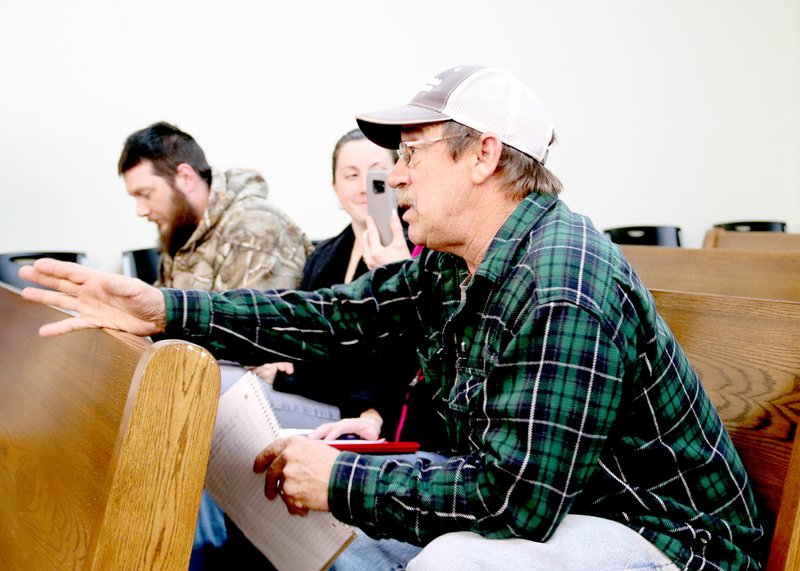PRAIRIE GROVE -- City officials have been trying to determine why residents living in the south and southwest parts of town deal with brown or yellow water from time to time, more so than the rest of the town.
Larry Oelrich, director of administrative services and public works, gave a presentation at the City Council's Jan. 15 meeting to discuss water quality, why tap water may be brown, what the city is doing about it and plans for the future.
The presentation was in response to many complaints on Facebook about brown water in Prairie Grove.
At one time, posts about brown water were being made on a Facebook page called Awesome Community of Prairie Grove, AR. The administrators for the page, however, stopped the messages, saying the page was not meant as a place for complaints. They encouraged people to call the city's Water Department with any concerns.
Now, a new Facebook page has been created, called Awesome Brown Water of Prairie Grove. It says the purpose of the page is for the community to come together and discuss the issue of brown water with a goal to have clear, clean water.
Several local residents attended the Council meeting with their concerns.
After the meeting, Rochelle Caswell, one of the administrators of the new Facebook page, said she moved back to Prairie Grove about four years ago and has dealt with dirty looking tap water since then.
"I've ruined hundreds of dollars of clothes," Caswell said, saying her water is constantly a faint yellow color. Caswell lives on Commercial Street.
Shavona Murphy, who lives on Herron Street, added her water is brown about once a month.
"There's no rhyme or reason to it," Murphy said.
Oelrich told those at the meeting he understands their concerns about water quality.
"We acknowledge there is a problem," Oelrich said. "We don't want any of you to have problems."
He said city staff believe most of Prairie Grove's problems are the result of rust deposits inside water lines breaking loose because of increased water flow.
"We think the majority of our problem is the velocity of water in that part of town," Oelrich said.
Water flow can increase because of water leaks, when fire hydrants are opened and during heavy water demand.
Chemistry changes in water also can result in brown or dirty water, he said.
The main remedy for brown water, according to Oelrich, is to flush the lines.
"A lot of times turning the faucet on in the kitchen will take care of it," Oelrich said. "Sometimes not and we'll come out and flush the lines."
The key, Oelrich said, is if turning on the faucet does not help, then call the Water Department and report the problem and a water department employee will come out to help.
The city has been trying to find where the problems originate by isolating sections of lines. Workers will shut off one part of a line and over time observe to see if it makes a difference, Oelrich said.
The section of town having problems has some PVC pipes but these are connected to steel pipes in the surrounding area. Oelrich said he suspects the problem is somewhere in the steel pipes and the rust is flowing to the south and southwest part of town.
"We've got to figure out where it's picking up the rust," Oelrich said, not an easy task because the city has miles of water lines buried underground.
The city has 60 miles of water lines and 14 miles of those lines are from 40-85 years old.
Oelrich said some have questioned why the city doesn't just raise rates and fix the problems.
Costs to replace water lines are expensive, Oelrich said. To replace one block of water line cost at least $100,000. With 2,500 customers on the Prairie Grove system, each would pay $40 toward that cost. To replace one mile, this tab would increase to $400. To replace 10 miles, the city would have to charge each customer $4,000 to come up with the money for the project.
Even with a new system of PVC pipes, discolored water will happen from time to time, Oelrich said, because minerals and chemicals overtime adhere to the insides of the lines and fire hydrants, valves and fittings are still capable of producing rust.
The city's next step in solving the puzzle, Oelrich said, will be part of a project to install a new water storage tank.
The city is getting ready to hire an engineer to help with this. The engineer's work will include completing a hydrologic profile of the city's water system. A profile will look at flow rates, water pressure and see where water is flowing and should be flowing.
Oelirch said water customers can help by documenting problems and reporting them to the city, not posting the information on Facebook.
"I'll read on Facebook about dirty water but no one has called us," Oelrich said.
The more information the city has, the better chance it will have to find the origination of the problem, he added.
David Ruff, another resident at the meeting, said he was not there to "fight with the city" but to work with the city.
"We just want to help you solve the problem," Ruff told Council members.
General News on 01/24/2018
